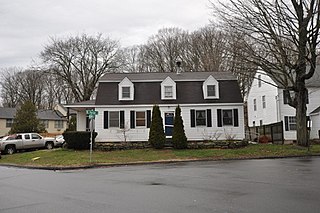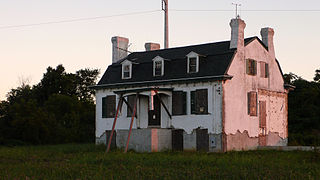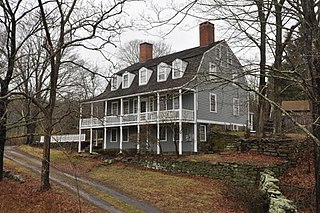
The Thomas Harrison House is a historic house at 23 North Harbor Street in Branford, Connecticut. Probably built before 1723, it is one of the town's small number of surviving 18th-century houses, that is further distinctive because of its gambrel roof. The house was listed on the National Register of Historic Places in 1988.

The Joshua Hempsted House is a historic house museum at 11 Hempstead Street in New London, Connecticut. Built about 1678 and altered several times during the 18th century, it is one of the state's oldest surviving buildings, and provides a virtual catalog of early construction methods due to its state of preservation. The house was acquired by Connecticut Landmarks in 1937, which operates it and the adjacent 1759 Nathaniel Hempstead House as a historic house museum complex known as the Hempsted Houses. The houses have been restored to reflect a late 17th to mid 18th-century appearance, and was listed on the National Register of Historic Places in 1970.

The Acadian House is a historic house on Union Street in Guilford, Connecticut. Built about 1670, it is one of Connecticut's oldest surviving houses, notable for its occupation by refugee Acadians following their 1755 deportation from Nova Scotia. The house was listed on the National Register of Historic Places in 1975.

The Nathaniel Backus House is a two-story Greek Revival clapboarded house with a gable roof in Norwich, Connecticut. The house was built around 1750 by Nathaniel Backus and served as his home, it was later moved to its current location in 1952. The house originally began as a Colonial, but was greatly modified to Greek Revival around 1825, reconfiguring the central door to the left of the facade and adding two chimneys. The house is a historic house museum operated by the Faith Trumbull Chapter of the Daughters of the American Revolution.

The Henry Champion House is a historic house on Westchester Road in Colchester, Connecticut. Built in 1790, it is a good local example of Federal period architecture, designed by William Sprat, a prominent early architect. It was built by Colonel Henry Champion, a veteran of the American Revolutionary War for his son, also named Henry. The house was listed on the National Register of Historic Places in 1972.

The Joseph Carpenter Silversmith Shop is a historic building that was built between 1772 and 1774 on the green in Norwichtown, now a section of Norwich, Connecticut. It is a 30 feet (9.1 m) by 24 feet (7.3 m) 1+1⁄2-story clapboarded building with a gambrel roof. The interior has a single brick chimney that was used for the forge, but it has been modified and adapted for modern use with modern doors, electric lighting and heat, and a disappearing overhead stairway that leads to the attic. Joseph Carpenter (1747–1804) was a successful of silversmith, clockmaker, and pewterer, and shared the building with his brother, a merchant. The shop was added to the National Register of Historic Places on October 6, 1970, and was listed as a contributory property for the Norwichtown Historic District on January 17, 1973.

The Hayward House is a historic house at 9 Hayward Avenue in Colchester, Connecticut. Built in 1775 and embellished in the late 19th century, it is a well-preserved 18th-century house, which has seen a number of locally prominent residents, as well as the nationally known inventor Nathaniel Hayward, who developed the process of vulcanizing rubber. The house was listed on the National Register of Historic Places in 1972.

The Shaw Mansion is a historic mansion and historic house museum at 11 Blinman Street in New London, Connecticut. Built in 1756, it is a well-preserved example of a wealthy merchant's house, made further notable as the location of the state's naval offices during the American Revolutionary War. It was added to the National Register of Historic Places in 1970. The headquarters and museum of the New London County Historical Society have been located in the Shaw Mansion since 1907.

The Whitehall Mansion is a historic house at 42 Whitehall Avenue in the Stonington side of Mystic, Connecticut. Built about 1771 for a local physician and politician, it is a fine example of late Georgian architecture. It has been moved twice, both times short distances, and now serves as a bed and breakfast inn. The house was added to the National Register of Historic Places on April 12, 1979.

The Hempstead Historic District of New London, Connecticut encompasses a residential area north of the city's harbor and central business district, extending mainly along three roughly parallel streets: Franklin and Hempstead Streets, and Mountain Avenue. The area was settled in the 17th century, and has three centuries of architecture depicting an increasingly urban area. The district was listed on the National Register of Historic Places on July 31, 1986.

The Dr. Daniel Lathrop School is a historic school building at 69 East Town Street in the Norwichtown section of Norwich, Connecticut. It is a single-story brick structure with a gambrel roof, located facing the village green next to the Joseph Carpenter Silversmith Shop, another historic building. Built in 1782, it is one of the oldest surviving brick school buildings in the state. The building was listed on the National Register of Historic Places on December 29, 1970. It now serves as a visitors center for the local historical society.

The Col. Joshua Huntington House is a historic house at 11 Huntington Lane in Norwich, Connecticut. Built in 1771, it is a well-preserved example of Georgian architecture in the city's Norwichtown area. It was built for Joshua Huntington, scion of a prominent family and a local military leader during the American Revolutionary War. The house was listed on the National Register of Historic Places on February 23, 1972.

The Michael Salyer Stone House is located on Blue Hill Road in Orangetown, New York, United States. It was built in the late 18th century.

The Makens Bemont House, commonly called the Huguenot House, is a historic house museum at 307 Burnside Avenue in East Hartford, Connecticut. Built in 1761, it is one of the town's few surviving 18th-century buildings, and is one of several buildings located in Martin Park that are operated by the Historical Society of East Hartford as the Historical Houses at Martin Park. It was listed on the National Register of Historic Places in 1982.

The James Morrow House is a historic farmhouse in Newark, Delaware. It was built in the late 1860s by James Morrow, an Irish immigrant who owned a store in Wilmington. The building is locally significant for its unusual architecture, which features both a gambrel roof and a raised basement. It was listed on the National Register of Historic Places in 1983.

The Hager Farm is a historic farmstead on United States Route 7 in southern Wallingford, Vermont. Its farmhouse, built about 1800, is one of the oldest in the community, and is regionally unusual because of its gambrel roof. The property was listed on the National Register of Historic Places in 1986.

130 Hayden Station Road is an unusual Colonial-era brick cottage in Windsor, Connecticut. Built in 1760 next to the Capt. Nathaniel Hayden House, it was probably built as a shoemaker's shop. It was listed on the National Register of Historic Places in 1988.

The Medad Stone Tavern is a historic house museum at 191 Three Mile Course in Guilford, Connecticut. Built in 1803 but never actually used as a tavern, it is well-preserved example of early 19th-century Federal period architecture. It is now maintained as a museum by a local historical society. It was listed on the National Register of Historic Places in 2009.

The Samuel Parsons House is a historic house museum at 180 South Main Street in Wallingford, Connecticut. Built about 1770, it is a well-preserved example of Georgian residential architecture. It has housed the local historical society since 1919. It was listed on the National Register of Historic Places in 1982.

The Plaster House is a historic house at 117 Plaster House Road in Southbury, Connecticut. Probably built in the mid-18th century, it is an extremely rare example of 18th-century stone residential construction in the state. The small structure may have originally been built as a farm outbuilding by a member of locally prominent Hinman family. It was listed on the National Register of Historic Places in 1993.






















